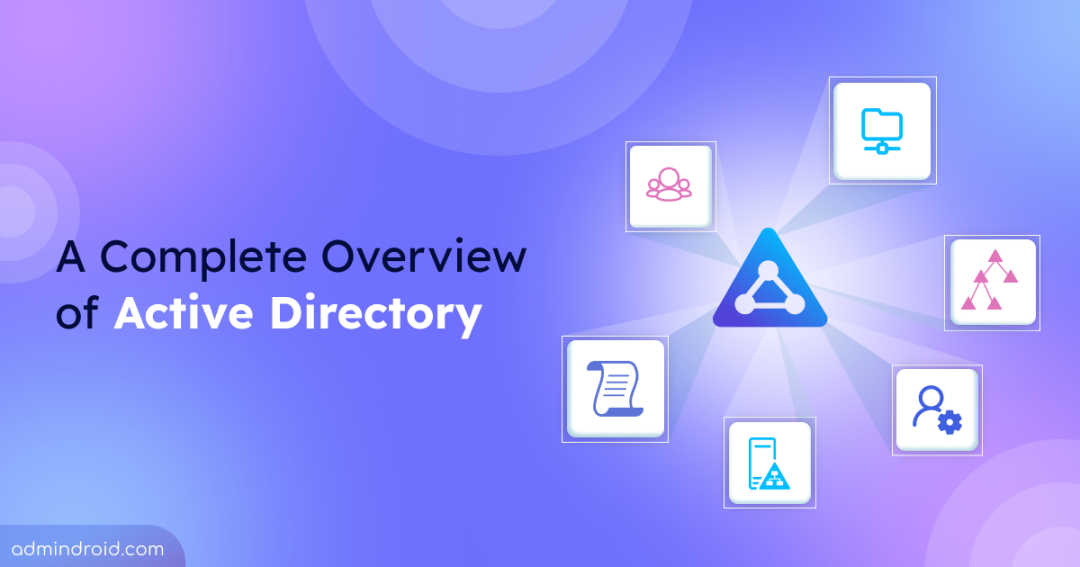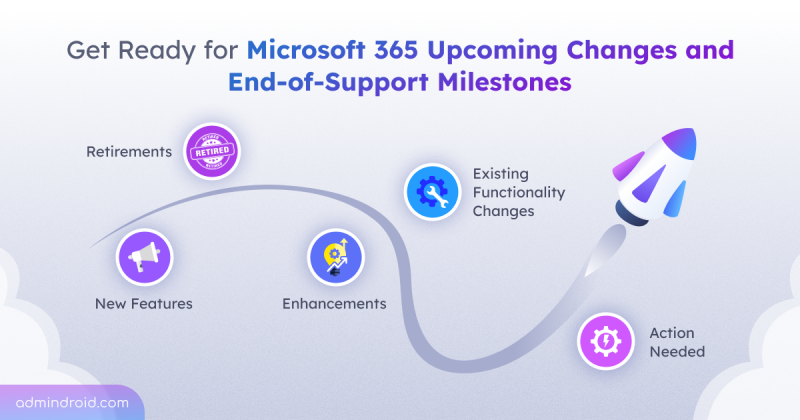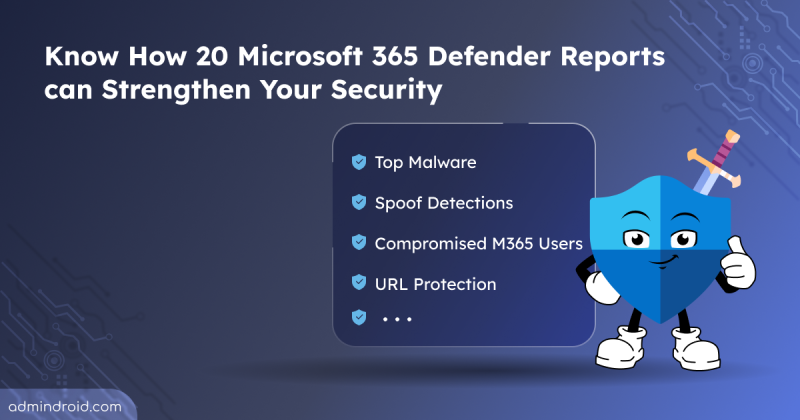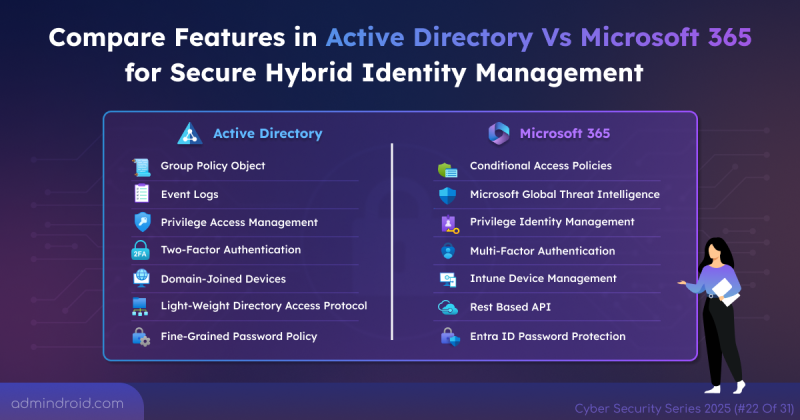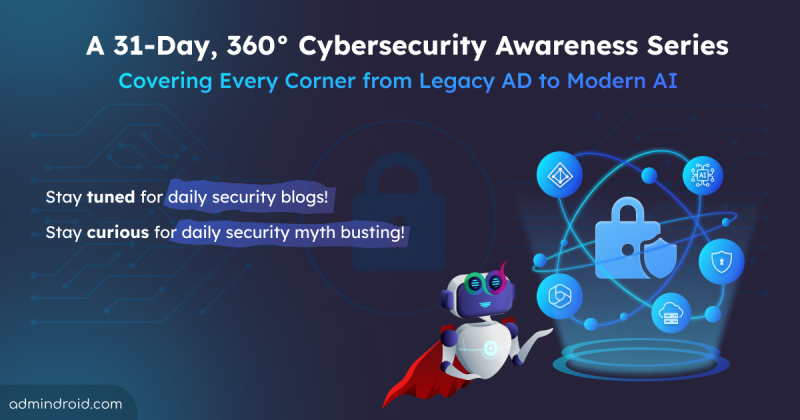Every time someone signs in to a computer or a service connects to a shared folder, there’s one invisible process at work — identity verification. Without a centralized system to handle those identities and permissions, network management would be fragmented, insecure, and nearly impossible to control.
That’s where Active Directory (AD) comes in — Microsoft’s cornerstone for enterprise identity and access management. AD acts as the centralized directory service of your Windows environment, offering a structured, scalable framework to manage users, devices, and resources across the organization. It enforces security policies, defines administrative boundaries, and keeps your entire Windows network organized and protected.
In this blog, let’s explore the core building blocks of Active Directory to understand how it forms the foundation of identity and access management in the Windows environment.
What is Active Directory?
Active Directory is Microsoft’s directory and identity management service, foundational to Windows domain networks in organizations of all sizes. It streamlines how resources, objects, and permissions are managed and accessed, making life easier for both admins and end users. Introduced with Windows 2000 Server, it remains the foundation of identity and access management in most enterprise environments today.
Essentially, it’s the core system that authenticates who you are and authorizes what you’re allowed to do, keeping the workplace secure and organized.
To understand Active Directory better, explore all its fundamentals to understand how each component plays a distinct role in smoother management.
- Core Services in Active Directory
- Logical Structure of Active Directory
- Active Directory Objects List
Understand All Core Services in Active Directory
The Active Directory consists of several core services to manage different aspects of a Windows-based network. With AD DS being the fundamental component, other services like AD FS, AD RMS, AD CS, and AD LDS extend its functionality for specific security and application scenarios. Let’s dive deep into all Active Directory services.
Active Directory Domain Services (AD DS)
AD DS is the core service that provides the foundation for Active Directory. It handles authentication and authorization while storing domain information in a hierarchical structure that makes resources easy to locate and manage. When the AD DS role is installed on a Windows server, it can be promoted to a Domain Controller (DC) – the central point that stores the AD database, handles user logins, enforces password policies, lockout settings, and more.
Active Directory Federation Services (AD FS)
AD FS enables federated identity management by securely sharing authentication information across organizational boundaries. This service provides Single Sign-On (SSO) functionality, allowing users to access multiple applications and systems both within and outside the domain using a single set of credentials.
Active Directory Rights Management Services (AD RMS)
AD RMS protects sensitive information in your domain using Information Rights Management (IRM) policies. When you apply IRM policies and assign specific access permissions to a document, workbook, or any other sensitive data, the content is encrypted. This prevents unauthorized copying, printing, forwarding, or editing, no matter where the information resides.
Active Directory Certificate Services (AD CS)
AD CS manages digital certificates for public key infrastructure (PKI) in Windows environments. It handles the creation, distribution, and validation of digital certificates used for encrypting data, securing communications, and verifying the identity of users, devices, and services.
Active Directory Lightweight Directory Services (AD LDS)
AD LDS is a lightweight, flexible directory service that provides directory functionality for applications without requiring a full domain deployment. It stores and manages application-specific data but doesn’t handle domain authentication or logins like AD DS, making it ideal for directory-enabled applications that need a dedicated data store.
Now that we know the services, let’s look at the framework in Active Directory.
The Logical Structure of Active Directory Environment
Active Directory may seem complex, but at its core, it’s all about structure—making it easier to manage users, devices, and resources across an entire network. The logical structure of AD acts like a blueprint, showing how everything fits together so you can keep objects secure, structured, and manageable.
A well-planned Active Directory logical structure simplifies managing thousands of objects, facilitates resource sharing, enables delegated administration, reduces attack surfaces, and ensures consistent policy enforcement across the organization.
The structure is built in layers, moving from the broadest container to the most specific. The key logical components include Forests, Trees, Domains, and Organizational Units (OUs).
Forest – The Root of the Active Directory Hierarchy
The Active Directory forest is the top-most logical structure in Active Directory. It holds one or more domain trees which share a common schema, configuration, and global catalog. A forest represents the security boundary in Active Directory — authentication, trust, and replication happen within this boundary. Each forest and domain operates at a specific functional level, which determines the available AD features based on the Windows Server version used. Higher functional levels unlock advanced features like improved authentication protocols, replication, and security enhancements.
All domains within a forest automatically share two-way, transitive trust relationships through Kerberos authentication, allowing seamless access between them. However, objects in separate forests can only interact if the admin of each forest creates trust between them. Forests can contain multiple domain trees with non-contiguous namespaces (for example, example.com and sample.org can exist in the same forest).
Domain Trees – Hierarchical Grouping of Related Domains
A domain tree is a collection of one or more domains connected in a hierarchy, sharing a contiguous namespace (for example: example.com, sales.example.com, hr.example.com). The top-level (root) domain acts as the parent domain, while any domains created under it are child domains. This establishes a crucial parent-child relationship that defines the domain’s name structure (the child domain name inherits the parent domain name).
All domains in a tree share a common schema and configuration. They are linked together through two-way transitive trust relationships to allow resource sharing and unified authentication across the tree.
Domains – Core Administrative and Security Units in Active Directory
A domain is the core administrative and security boundary within Active Directory. It contains a collection of objects such as users, groups, and computers that share the same directory database and security policies.
Every domain has a unique DNS name (e.g., corp.example.com). Each domain has its own directory database and is managed by one or more Domain Controllers (DCs) that can handle:
- Authentication and authorization
- Replication between other DCs
- Policy enforcement via Group Policy
Domains are logically independent but connect multiple objects across different physical locations. To optimize network traffic and replication efficiency across different physical regions or data centers, the domain’s structure is mapped onto one or more Sites.
Organizational Units – Logical Containers for Object Management
Imagine putting every user and computer in one giant folder — sounds messy, right? That’s why we have Organizational Units (OUs). OUs are used to group objects logically, such as by role, department, etc.
Active Directory OUs are also used for:
- Delegating administrative control to ensure least privilege
- Applying Group Policies to a specific set of users or devices
- Structuring the domain logically to mirror business units
By designing OUs carefully, you can make Active Directory management simple and effective, even in large enterprises. With the framework in place, let’s now move to the inhabitants of the Active Directory.
What are the Key Components of Active Directory
Active Directory objects are the individual elements that represent resources in a network, such as users, groups, computers, printers, and more. Each object stores information as a set of attributes (like a name, email, or department) defined by the AD schema. These attributes make it easy to search for and manage objects in a large environment.
Now that we have a clear idea of what an object in Active Directory is, let’s look at some of the main object types.
User
A User object is a representation of an individual identity in an organization. It can be any user who needs access to the domain. Each user object has a unique Security Identifier (SID) and attributes such as first name, last name, password, email address, and more. User objects are essential for authentication and access control within the domain.
Group
Groups in Active Directory are designed to simplify access management and communication by bringing related objects together. Instead of assigning permissions or configurations to individual users, you can apply them to a group as a whole. A group can include objects like users, computers, contacts, or even other groups. Groups are of two types:
- Security groups: Used for assigning permissions and controlling access to network resources. Each security group has a defined set of permissions. When a member is added to a group, they automatically inherit the permissions assigned to it. For example, if a user is added to the Administrators group, they gain admin privileges and can access everything across the domain.
- Distribution groups: Primarily used for email communication within Active Directory environments. These groups don’t have security permissions, but simplify sending messages to multiple users at once through a single group address.
Active Directory includes several built-in security groups, like Domain Admins and Account Operators, with predefined permissions. You can also create custom groups as needed, but it’s best to keep the number manageable to keep administration simple and efficient.
Each AD Group has a scope, such as Domain Local, Global, and Universal, that defines the group’s reach within the domain or forest. It also defines the areas of the network where permissions can be granted for the group.
| Group Scope | Membership | Permission Scope | Members Of |
| Domain Local | Users, computers, Global groups, and Universal groups from any domain or trusted domain. Other Domain Local groups from the same domain. | Can grant permission within the same domain. | Other Domain Local groups from the same domain. |
| Global | Users, computers, and other Global groups from the same domain. | On any domain in the same forest, trusted domains, or trusted forests. | Universal groups (any domain in the forest), Domain Local group (any domain in the forest or trusted domain), and other Global groups (same domain). |
| Universal | Users, computers, Global groups, and other Universal groups from any domain in the same forest. | On any domain in the same forest or trusted forests. | Other Universal groups in the same forest or Domain Local groups in the same or trusting forests. |
Computer
A Computer object represents a physical or virtual computer in a domain. Like user objects, each computer object has a unique SID and carries attributes such as computer name, operating system, etc. When a computer joins a domain, a computer object is automatically created for it. This object is used to configure computer properties, manage access, and define user login permissions.
Computers in Active Directory can be of several types:
- Domain Controller – A Domain Controller is a centralized Windows Server that hosts the Active Directory Domain Services. It authenticates users, enforces security policies, and manages domain resources. It also holds Active Directory FSMO (Flexible Single Master Operations) roles to perform specialized functions crucial for maintaining consistency and proper operation across the domain or forest.
In branch offices or locations with limited security, a special type of DC called a Read-Only Domain Controller (RODC) can be deployed. RODCs hold a non-writable copy of the database and prevent caching of privileged account credentials, offering a reduced attack surface. - Member Server – A Member Server is a domain-joined server that does not function as a Domain Controller. It usually hosts other services such as Exchange Server, Web Server, or File Server.
- Workstation – These are computers joined to the domain—typically desktops or laptops. Users can sign in to these systems using their domain credentials.
Contact
A contact object in Active Directory represents a user who is not part of the organization’s domain. These objects don’t have logon credentials and can’t access domain resources. Instead, they’re used to store contact details such as name, email address, phone number, and other relevant information. Contact objects are especially useful for including external users in address lists or distribution groups without granting them network access.
Organizational Unit
An Organizational Unit (OU) is a container object used to logically group users, computers, or groups based on department, function, or location — for example, HR OU, IT OU, Finance OU, etc. Unlike regular containers, OUs can have Group Policy Objects (GPOs) linked directly to them. This allows administrators to apply specific configurations, restrictions, or security policies to all objects within the OU.
OUs can also be nested, creating a hierarchical structure that mirrors the organization’s functional setup. This nested OU structure helps delegate administrative control and apply targeted group policies at different levels.
Group Policy Object
A Group Policy Object (GPO) is a powerful component of Active Directory that lets you control the settings and behaviour of systems and users within the domain. GPOs control settings such as password policies, software deployment, startup scripts, and security configurations. They can be linked to sites, domains, or OUs to enforce Active Directory security settings across the organization.
Printer
A Printer object represents a real printer available in the organization. It includes details such as the printer name, driver name, color mode, port number, and other configuration data. Publishing printers in Active Directory helps users easily search and connect to available printers based on their location or department.
Shared Folder
A Shared Folder object represents a shared network resource in Active Directory. When you publish a new shared folder in AD, an object is created for it. This makes it easier for users to find and access shared files and directories without needing to remember paths or server names.
Service Accounts
Service Accounts in Active Directory are special accounts used by applications or services to run and access network resources without human intervention. These accounts simplify service authentication and automate password management, making them more secure and easier to maintain.
There are two main types of managed service accounts:
- Standalone Managed Service Account (sMSA): Designed for services running on a single server. It can support multiple services on that same server and automatically manages its own password.
- Group Managed Service Account (gMSA): Can be used to run services across multiple servers, ideal for load-balanced or clustered services. A gMSA can also support services running on a single server.
And there you have it—the world of Active Directory, clear and simplified. We’ve walked through the core services, explored the logical structure that keeps everything organized, and met the key objects that make it all work.
We hope this guide has helped you build a stronger understanding of Active Directory. Now that you’re familiar with how it works, the next step is to set up your own Active Directory lab and put that knowledge into practice. If you have any questions or thoughts about Active Directory, feel free to share them in the comments below — we’re happy to help!
